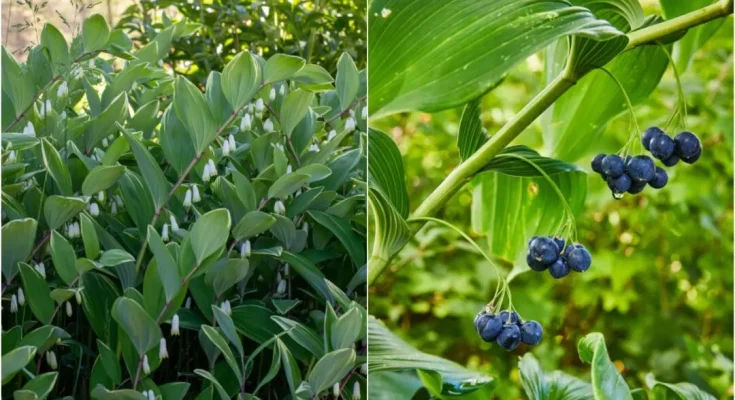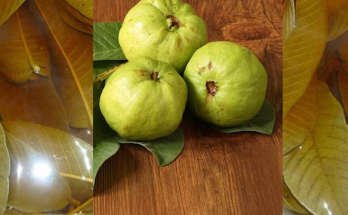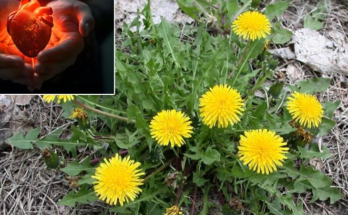Perennials are a staple when it comes to adding visual interest and appeal to our outdoor living spaces. These trusty plants come back year after year, making them an easy-care choice over many annuals.
When it comes to planting perennials, it’s easy to pick out plants for the sunny parts of your yard.
Take your pick from hundreds of sun-loving plants, whether you’re looking for stunning foliage or striking flowers.

But in the shadier areas of the yard, your selection begins to drop off.
Sure, there are hostas, but you can only plant so many hostas before you get tired of them. And lily of the valley is nice during the spring, but once the flowers are gone, they’re kind of boring.
If you’re on the hunt for a shade-loving perennial that is easy to grow, beautiful from spring to fall, and not one of the same old shady standbys, then may I humbly recommend Solomon’s seal?

This versatile plant has so much going for it. I’m a little surprised that I don’t see it more often in people’s landscapes.
Solomon’s seal, or Polygonatum, is a stately, mid-sized perennial that grows from rhizomes in the soil. Their leaves zig-zag up the sloping stem in a pleasing asymmetrical balance. And small clusters of bells dangle from below in a line down the stem.
The name is said to come from the small scars that appear on the rhizomes each year after a stem is produced. The scars look a bit like two inverted triangles, which was the symbol of King Solomon.
Both native and exotic species are available to grow as an ornamental, although many more species grow in the wild. All told, there are roughly 60 different specimens in this genus. Most have leaves of one color, but there are a couple of exotic species with variegated foliage, and some have bright magenta stems offering another pop of visual interest, such as P. variegatum.
Most polygonatums grow between 18”-36” tall, making them a great mid-range option in your flower garden. Although, P. biflorum can grow as tall as six feet.
For gardeners who appreciate structural beauty and foliage along with flowers, it’s hard to beat Solomon’s seal. But if you still need some convincing, I’ve got some pretty good reasons to grow this stately perennial.
1. Solomon’s Seal Loves All Types of Shade

Those sun-loving perennials always seem to get the attention with their big, showy blooms. But if you’ve got a shaded area, Solomon’s seal fits the bill. They will grow in dappled shade, full shade, and they even do well in areas that get a few hours of sun a day and are shaded for the rest.
If you’ve got shade, Solomon’s Seal will grow there.
2. Solomon’s Seal Offers Three-Season Beauty

From spring until the fall, Solomon’s seal is a stunning perennial, adding both foliage and flowers to your landscape. In the spring, their vibrant, fresh green leaves are one of the first perennials on the scene. In mid to late spring, they bloom in clusters of fairy flowers in cream or yellow-green.
As the summer begins to heat up and the flowers fade, deep gray-blue berries develop, offering a shift in color and form. If you’re an avid birder, you’ll want to add these plants to your garden, as the birds love the small grape-like berries. (The berries are toxic to humans, though, so leave them for your feathered friends.)

When the weather begins to cool, and the leaves on the trees begin to turn color, you’ll notice the same of your Solomon’s seal. The leaves will turn a lovely gold in the fall before giving way altogether to cooler winter temperatures.

If you want beauty that lasts through the growing season, Solomon’s seal is an excellent option.
3. Solomon’s Seal is Incredibly Easy to Grow
Perennials can be a mixed bag. Some can take forever to fill in, while others will take over your yard the moment you put them in the soil. You might have to invest time dead-heading if you want continuous blooms. And some can be pretty finicky about the soil, sunlight and water they get.
But not Solomon’s seal; I can’t think of a less fussy flowering perennial to grow.
Once they are settled, they’re surprisingly drought-tolerant.
Did I mention they like shade?
Solomon’s seal does well, even if you don’t divide it. That’s because it’s not an aggressive spreader. It will fill in spots nicely without overtaking the entire flower bed.

There are no flowers to dead-head, and at the end of the season, you can simply let the dead stalks become mulch for next year’s plants. They’re deer-resistant, pest-resistant and disease-resistant. It truly is a set-it-and-forget-it perennial.
Bonus – You Can Eat the Shoots

I love foraging in the spring. There are so many delicious, green things to eat. It’s always a welcome change after a winter of heavy foods.
What I really love is being able to forage right out my front door. Solomon’s seal shoots are a delicious, crunchy alternative to asparagus, which isn’t surprising as they’re in the same family. They have a similar flavor profile, with the Solomon’s Seal being a touch sweeter.
These are tasty, sought-after shoots in the foraging world, but often, finding a patch big enough to harvest sustainably can be tough. It’s so much easier to grow them yourself.
Planting and Caring For Solomon’s Seal

While you can grow Solomon’s seal from seed, I wouldn’t recommend it. It takes several years for the plant to mature and begin to bloom. It’s much easier to grow this perennial from rhizomes either purchased or from division.
Solomon’s seal can be planted in the spring or fall.
It’s always a good idea to dig in some compost in the area where you intend to grow Solomon’s seal. This will provide plenty of organic matter to help retain moisture while the plant gets established. Depending on how large the rhizomes are, you may want to cut or break them into smaller sections. Just be certain each new section has growing nodes.

Plant the rhizomes (lengthwise) about 4-6 inches deep and about every three feet. This will allow them room to spread and fill in.
Water them in well. Until the plant is established, continue to water them as necessary. While the plant is fairly drought tolerant, that’s only mature plants. But, like most plants, if you have extended periods with no rain, they do like a little drink.
Solomon’s seal is hardy in Zones 3-9, although it likes cooler temperatures more than hot.
To support growth and blooming, apply compost or fertilizer each year.




벼룩시장 구인구직 및 신문 그대로 보기 (PC/모바일) | 구인구직 앱 어플 무료 설치 다운로드 | 모바일 벼룩시장 보는 방법 | 벼룩시장 부동산 | 지역별 벼룩시장 | 벼룩시장 종이신문 에 대해 알아보겠습니다. 섹스카지노사이트